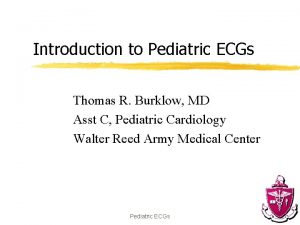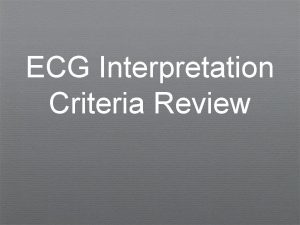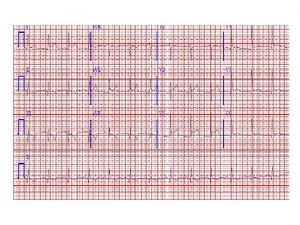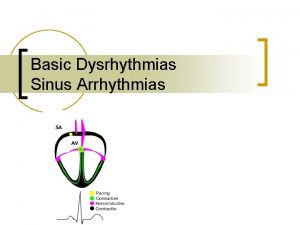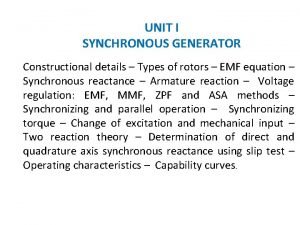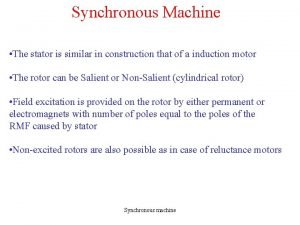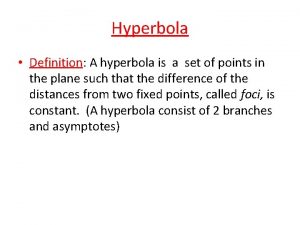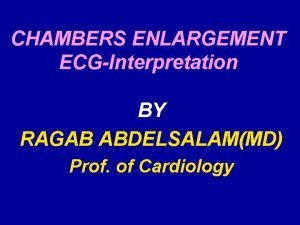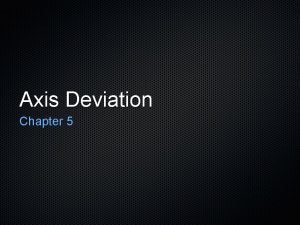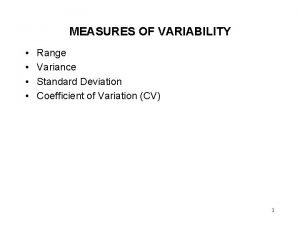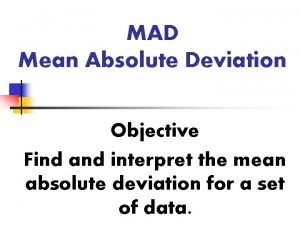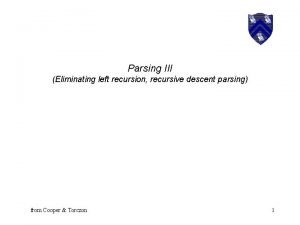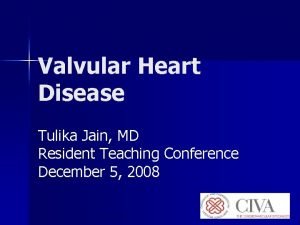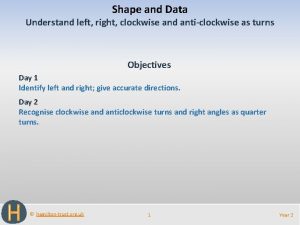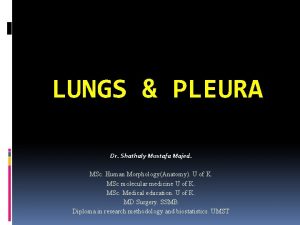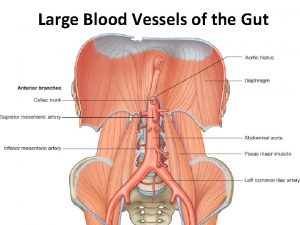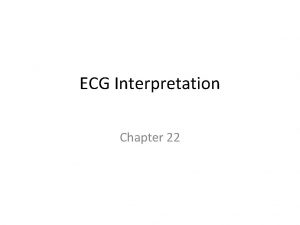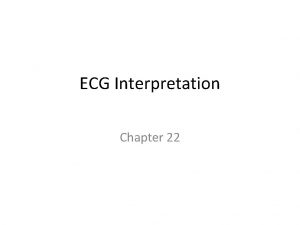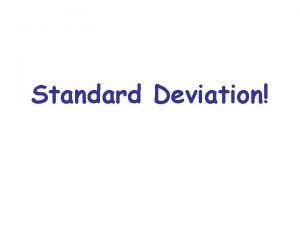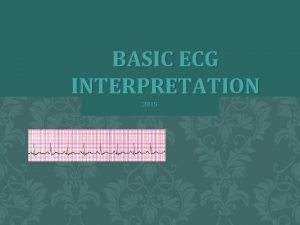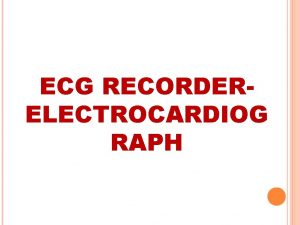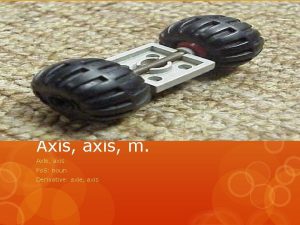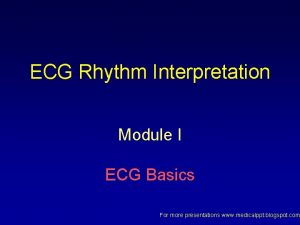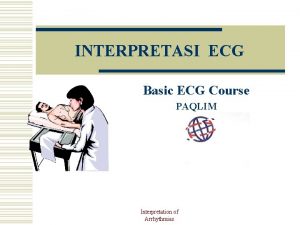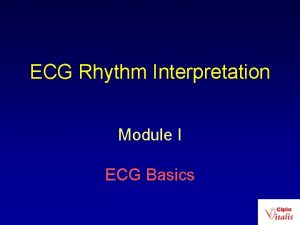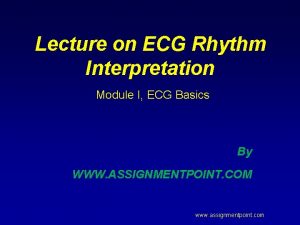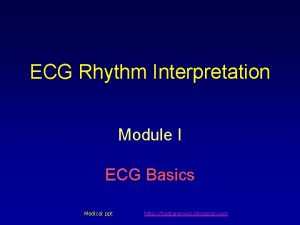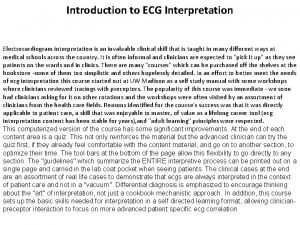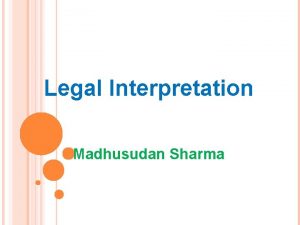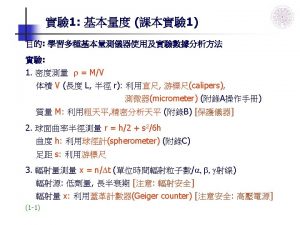ECG Interpretation Criteria Review Axis Deviation Left Right



















































- Slides: 51

ECG Interpretation Criteria Review

Axis Deviation Left Right ✦ ✦ RAD = If R wave in III > R wave in II LAD = If R wave in a. VL > I; and deep S wave in III

Axis Deviation Criteria LEAD II (or Lead a. VF or III) Normal Positive LAD Positive Negative RAD Negative Positive Intermediate axis Negative

Axis Deviation ✦ LAD = possible left anterior fasicular block ✦ RAD = possible left posterior fasicular block

Right Atrial Abnormality Criteria ✦ Tall P waves in lead II ✦ (or III, a. VF and sometimes V 1)

Left Atrial Abnormality • Lead II (and I) show wide P waves • • • (second hump due to delayed depolarization of the left atrium) (P mitrale: mitral valve disease) V 1 may show a bi-phasic P wave • • 1 box wide, 1 box deep (biphasic since right atria is anterior to the left atria)

Right Ventricular Hypertrophy Criteria 1. In V 1, R wave is greater than the S wave - or - R in V 1 greater than 7 mm 2. Right axis deviation 3. In V 1, T wave inversion (reason unknown)

Left Ventricular Hypertrophy Criteria ✦ If S wave in V 1 or V 2 + R wave in V 5 or V 6 ≥ 35 mm. . . ✦ . . . or, R wave > 11 (or 13) mm in a. VL or I. . . ✦ . . . or, R in I + S in III > 25 mm. ✦ Also ✦ LVH is more likely with a “strain pattern” or ST segment changes ✦ Left axis deviation ✦ Left atrial abnormality

Right Bundle Branch Block Criteria ✦ V 1 or V 2 = r. SR’ - “M” or rabbit ear shape ✦ V 5 or V 6 = q. RS ✦ Large R waves ✦ Right chest leads: T wave inversion (“secondary changes” since they reflect a delay in depolarization not an actual change in depolarization). ✦ Complete RBBB: QRS > 0. 12 sec. ✦ Incomplete RBBB: QRS = 0. 10 to 0. 12 sec.

Left Bundle Branch Block Criteria ✦ Wide QRS complex ✦ V 1 = QS (or r. S) and may have a “W” shape to it. ✦ ✦ V 6 = R or notched R and may show a “M” shape or rabbit ears Secondary T wave inversion ✦ Secondary if in lead with tall R waves ✦ Primary if in right precordial leads

Incomplete Bundle Branch Blocks ✦ RBBB or LBBB where QRS is between. 10 and. 12 with same QRS features

Left Anterior Fascicular Block ✦ Limb leads ✦ QRS less width less than 0. 12 sec. ✦ QRS axis = Left axis deviation (-45° or more) ✦ if S wave in a. VF is greater than R wave in lead I ✦ small Q wave in lead I, a. V , or V 6 L

Left Posterior Fascicular Block ✦ ✦ ✦ Right axis deviation (QRS axis +120° or more) S wave in lead I and a Q wave in lead III (S 1 Q 3) Rare

Bifascicular Block ✦ ✦ Two of the three fascicles are blocked. Most common is RBBB with left anterior fascicular block.

Subendocardial Ischemia Partial occlusion Transmural Infarction (MI) Complete occlusion

✦ ✦ ✦ A. Normal ECG prior to MI B. Hyperacute T wave changes - increased T wave amplitude and width; may also see ST elevation C. Marked ST elevation with hyperacute T wave changes (transmural injury) D. Pathologic Q waves, less ST elevation, terminal T wave inversion (necrosis) E. Pathologic Q waves, T wave inversion (necrosis and fibrosis) F. Pathologic Q waves, upright T waves (fibrosis)

Infarction

Anterior Infarctions ✦ ✦ Abnormal Q waves in chest leads Anterior MI can show loss of R wave progression in the chest leads

Inferior Infarctions ✦ Abnormal Q waves in leads II, III, and a. VF

Lateral ✦ ✦ Lateral - V 5 and V 6 High lateral when ST elevation and Q waves localized to leads I and a. VL

Posterior MI ✦ Tall R waves in V 1, V 2 ✦ ✦ ✦ R/S ratio > 1 in V 1, V 2 The tall, anterior R waves are mirror images of a pathological, posterior Q waves. Absences of right axis deviation (found with RVH) ✦ ST segment depression in V 1 -V 3 ✦ Often seen with inferior MI


Infarctions or BBB ✦ RBBB & LBBB ✦ ✦ T wave inversion and ST segment depression in V 1 & V 2 (RBBB) and V 5 & V 6 (LBBB) MI ✦ ✦ T wave inversion and ST segment depression in additional leads Likely loss of R wave progression

Infarctions and BBB ✦ RBBB and MI ✦ ✦ usual ECG changes in leads other than V 1 and V 2 septal MI - upright T waves in V 1 and V 2 ✦ with just RBBB the T waves should be inverted so upright T waves w/ RBBB are “abnormal” and indicated septal MI

Infarctions and LBBB ✦ ✦ ✦ Infarctions often damage the left bundle branch leading to a new or recent LBBB expect to see upright T waves in left chest leads septal MI are very difficult to assess with LBBB

Subendocardial Ischemia ✦ ST Segment depression ✦ ✦ ✦ Anterior leads (I, a. Vl and V 1 -V 6) Inferior leads (II, III, and a. Vf) may see ST segment elevation in a. Vr ✦ T wave inversion ✦ Poor R wave progression

Subendocardial Infarction ✦ No Q waves (non-Q wave infarction) ✦ Persistent ST segment depression ✦ T wave inversion

Sinus Bradycardia ✦ HR less than 60 bpm

Sinus Tachycardia ✦ HR > 100 bpm

Premature Atrial Complexes (PAC) 1. Normal conduction 2. Conducted with aberration ✦ a fascicles or bundle branch is refractory ✦ wide QRS 3. Non-conducted ✦ ✦ the AV node was still refractory; P wave will be close to the T wave no QRS complex

Atrial Tachycardia

AV Nodal Reentrant Tachycardia Figure 14 -6 ✦ ✦ ✦ Rapid recirculating impluse in the AV node area (140 -250 beats/min) No P waves (hidden in QRS complex) or may be just before or after the QRS complex Negative P waves in lead II

Atrial Flutter ✦ Sawtooth; F waves (easiest seen in II, III, & a. VF) ✦ Atrial rate of about 300 bpm ✦ Ventricular rate 150, 100 or 75 beats/min ✦ 2: 1, 3: 1 and 4: 1

Atrial Fibrillation ✦ ✦ No organized depolarization in atria. Irregular “f waves” can range from looking almost like P waves to a flat line. Atrial rate is about 600 bpm Normal QRS w/ ventricular rate ~110 -180 but random & irregular

Junctional Rhythm

Accelerated Junctional Rhythm

WPW

First Degree AV Block

2 nd Degree AV Block, Type 1

2 nd Degree AV Block, Type 2

2 rd Degree AV Block

Premature Ventricular Contractions ✦Characteristics 1. Premature and occur before the next normal beat 2. Wide (> 0. 12 ms) and the T wave is usually opposite of the QRS 3. Bizarre looking ✦ PVCs usually precede a P wave. ✦ A nonsinus P wave may follow the PVC

PVC ✦ Unifocal (monomorphic) PVCs ✦ same appearance in the same lead ✦ small focus ✦ normal and diseased hearts

PVC ✦ Polymorphic (multifocal and multiform) PVCs ✦ different appearance in the same lead ✦ multiform = different coupling intervals ✦ multifocal = same coupling intervals ✦ usually diseased hearts Multiform

Idioventricular Rhythm

Couplet

Triplet

Bigeminy and Trigeminy

Ventricular Tachycardia. . . more than three PVCs

Torsades de Pointes

Ventricular Fibrillation Note the course and fine waves
 Left left right right turn around go go go
Left left right right turn around go go go Left left right right go go go
Left left right right go go go Right product right place right time right price
Right product right place right time right price Family time
Family time Short pr intervals
Short pr intervals Unifocal pvc
Unifocal pvc The right man on the right place at the right time
The right man on the right place at the right time Axis wheel ecg
Axis wheel ecg Ecg rhythm strip interpretation basic lesson 6
Ecg rhythm strip interpretation basic lesson 6 Pitch factor formula
Pitch factor formula Advantages of self control synchronous motor
Advantages of self control synchronous motor Axis 1 and axis 2 disorders
Axis 1 and axis 2 disorders Length of transverse axis of hyperbola
Length of transverse axis of hyperbola Four conic sections
Four conic sections Axis 1 and axis 2 disorders
Axis 1 and axis 2 disorders Sick sinus syndrome ecg criteria
Sick sinus syndrome ecg criteria Pac ecg
Pac ecg Right atrial enlargement ecg
Right atrial enlargement ecg Axis deviation chart
Axis deviation chart Absolute deviation calculator
Absolute deviation calculator Standard deviation interpretation example
Standard deviation interpretation example How to find the mean absolute deviation
How to find the mean absolute deviation How does interpretation b differ from interpretation a
How does interpretation b differ from interpretation a Right atrial abnormality ecg
Right atrial abnormality ecg House left vs stage left
House left vs stage left Walk straight and turn
Walk straight and turn Muscle energy technique si joint
Muscle energy technique si joint For top-down parsing left recursion removal is
For top-down parsing left recursion removal is You put your right foot in
You put your right foot in Standard deviation review
Standard deviation review Standard deviation review
Standard deviation review Criteria for selecting the right scm tool is based on
Criteria for selecting the right scm tool is based on You can't turn right here. you turn left
You can't turn right here. you turn left Right sided vs left sided murmurs
Right sided vs left sided murmurs 이진트리 복사 순회
이진트리 복사 순회 Answer. go straight turn left turn right
Answer. go straight turn left turn right Right to left strategic planning framework
Right to left strategic planning framework Left right story game for summer
Left right story game for summer Steer horn stomach
Steer horn stomach Stage right and left
Stage right and left Proscenium stage directions
Proscenium stage directions Stage left and right
Stage left and right Anticlockwise direction
Anticlockwise direction Political spectrum canada
Political spectrum canada Periodic table of elements atomic radius
Periodic table of elements atomic radius Method study flow process chart
Method study flow process chart Hospitaliers meaning
Hospitaliers meaning Primary bronchi
Primary bronchi Look up look down look around
Look up look down look around Uniform bell-shaped skewed-right skewed-left
Uniform bell-shaped skewed-right skewed-left Where is the left gastric artery
Where is the left gastric artery Stage right stage left
Stage right stage left




